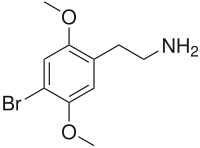
Photo from wikipedia
Abstract The pharmacokinetics of brexpiprazole were investigated in the in vitro and in vivo. The total body clearance of brexpiprazole in rat and monkey was 2.32 and 0.326 L/h/kg, respectively, after… Click to show full abstract
Abstract The pharmacokinetics of brexpiprazole were investigated in the in vitro and in vivo. The total body clearance of brexpiprazole in rat and monkey was 2.32 and 0.326 L/h/kg, respectively, after intravenous administration, and oral availability was 13.6% and 31.0%, respectively. Dose-dependent exposures were observed at dose ranges between 1–30 mg/kg in the rat and 0.1–3 mg/kg in the monkey. Brexpiprazole distributed widely to body tissues, and Vd,z were 2.81 and 1.82 L/kg in rat and monkey, respectively. The serum protein binding of brexpiprazole was 99% or more in animals and human. Uniform distribution character among the species was suggested by a traditional animal scale-up method. A common main metabolite, DM-3411 was found in animals and humans in the metabolic reactions with the liver S9 fraction. CYP3A4 and CYP2D6 were predominantly involved in the metabolism. The affinity of DM-3411 for D2 receptors was lower than that of brexpiprazole, and neither DM-3411 nor any metabolites with affinity other than M3 were detected in the brain, demonstrating that brexpiprazole is only involved in the pharmacological effects. Overall, brexpiprazole has a simple pharmacokinetic profile with good metabolic stability, linear kinetics, and no remarkable species differences with regard to metabolism and tissue distribution.
Journal Title: Xenobiotica
Year Published: 2021
Link to full text (if available)
Share on Social Media: Sign Up to like & get
recommendations!